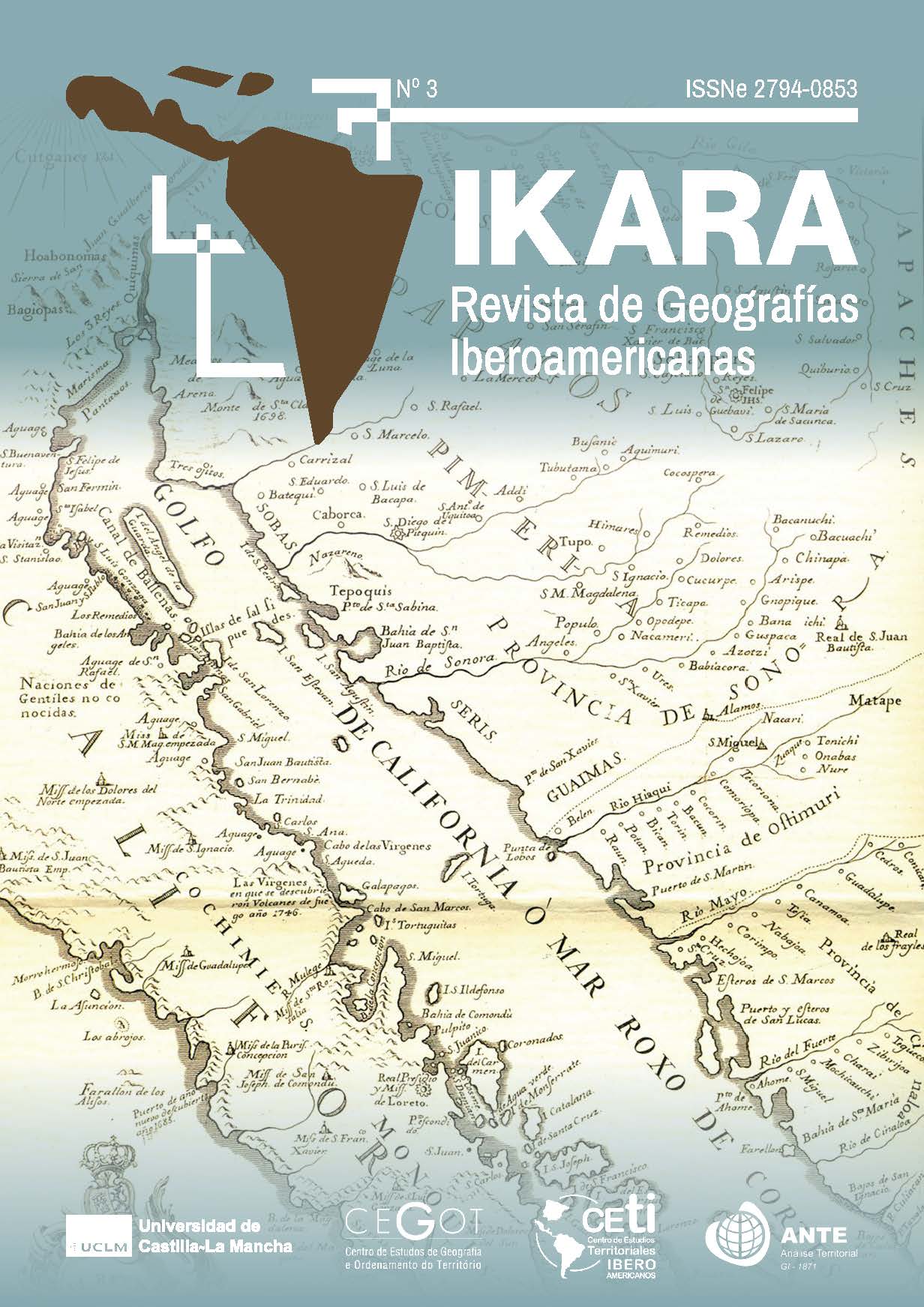La justicia ambiental en ciudades latinoamericanas: una revisión de los indicadores utilizados para su análisis
DOI:
https://doi.org/10.18239/Ikara.3325Palabras clave:
justicia ambiental, indicadores, desigualdad urbana, equidad ambiental, revisión bibliográficaResumen
Si bien son diversos los estudios que han buscado aplicar herramientas para medir y explicar las desigualdades socio-ambientales en el mundo, existe un menor desarrollo de la investigación desde un enfoque cuantitativo de la justicia ambiental (JA) en el sur global y en particular en América Latina. Este trabajo busca identificar y clasificar los indicadores que han sido utilizados recientemente para medir la JA en zonas urbanas de Latinoamérica. Se realizó una revisión bibliográfica utilizando tres bases de datos diferentes. Se identificaron 23 estudios distribuidos en 14 países. La mayor parte de indicadores se utilizan para medir aspectos positivos del ambiente al tiempo que el nivel socioeconómico de la población es el principal factor social considerado. El estudio da cuenta de un campo de investigación en desarrollo que evidencia desigualdades entre países y donde existe un sesgo entre estudios centrados en algunos aspectos de la JA.
Referencias
Acosta, F., & Haroon, S. (2021). Memorial parking trees: Resilient modular design with nature-based solutions in vulnerable urban areas. Land, 10(3). https://doi.org/10.3390/land10030298
Amorim Maia, A.T., Calcagni, F., Timothy Connolly, J.J., Anguelovski, I., & Langemeyer, J. (2020). Hidden drivers of social injustice: uncovering unequal cultural ecosystem services behind green gentrification. Environmental Science & Policy, 112, 254-263. https://doi.org/10.1016/j.envsci.2020.05.021
Anguelovsky, I. (2020, 21-25 de septiembre). Por una justicia ambiental urbana y feminista. Curso 'El feminismo después de la pandemia. Instituto de la Mujer y para la Igualdad de Oportunidades y Centro de Estudios de Género de la UNED [Video]. YouTube. https://www.youtube.com/watch?v=jBzt34L9iuo
Anguelovski, I., Connolly, J.J.T., Masip, L., & Pearsall, H. (2018). Assessing green gentrification in historically disenfranchised neighborhoods: a longitudinal and spatial analysis of Barcelona. Urban Geography, 39(3), 458-491. https://doi.org/10.1080/02723638.2017.1349987
Bellini, J.H., Stephan, Í.I.C., & Gleriani, J.M. (2016). The environmental inequality analysis in rio das Ostras-Rj, Brazil, using AHP (analitic hierarchy process) technique . RA’E GA - O Espaco Geografico em Analise, 38, 82-106. https://doi.org/10.5380/raega.v38i0.42051
Bonilla-Bedoya, S., Estrella, A., Santos, F., & Herrera, M.A. (2020). Forests and urban green areas as tools to address the challenges of sustainability in Latin American urban socio-ecological systems. Applied Geography, 125. https://doi.org/10.1016/j.apgeog.2020.102343
Bosisio, A., & Moreno Jimenez, A. (2019). Measuring environmental injustice on vulnerable and deprived populations caused by pluvial waterlogging: a gis-based analysis in santa fe de la vera cruz (argentina). Estudios Geograficos, 80(287). https://doi.org/10.3989/estgeogr.201937.017
Boso, A., Martinez, A., Somos, M., Alvarez, B., Avedano, C., & Hofflinger, A. (2022). No Country for Old Men. Assessing Socio-Spatial Relationships Between Air Quality Perceptions and Exposures in Southern Chile. Applied Spatial Analysis And Policy, 15, 1219-1236. https://doi.org/10.1007/s12061-022-09446-2
Cardenas, M., Fredy Escobar, J., & Gutierrez, K. (2020). Territorial equity in Medellin: public space, natural hazards and air quality. Estudios Socioterritoriales, 27. https://doi.org/10.37838/unicen/est.27-046
Escobedo, F.J., Clerici, N., Staudhammer, C.L., & Corzo, G.T. (2015). Socio-ecological dynamics and inequality in Bogotá, Colombia’s public urban forests and their ecosystem services. Urban Forestry and Urban Greening, 14(4), 1040-1053. https://doi.org/10.1016/j.ufug.2015.09.011
Ferraz, A. (2013). Urbanization, Environmental Justice, and Social-Environmental Vulnerability. En Brazil. In C. Boone & M. Fragkias (Eds.), Urbanization and Sustainability. Human-Environment Interactions (pp. 95-116). Springer. https://doi.org/10.1007/978-94-007-5666-3_7
Fernández-Álvarez, R. (2017). Inequitable distribution of green public space in Mexico City: an environmental injustice case TT - Distribución inequitativa del espacio público verde en Ciudad de México: un caso de injusticia ambiental. Economía, Sociedad y Territorio, 17(54), 399-428. https://doi.org/10.22136/est002017697
Fernandez, I.C., & Wu, J. (2016). Assessing environmental inequalities in the city of Santiago (Chile) with a hierarchical multiscale approach. Applied Geography, 74, 160-169. https://doi.org/10.1016/j.apgeog.2016.07.012
Fernandez, I.C., & Wu, J. (2018). A GIS-based framework to identify priority areas for urban environmental inequity mitigation and its application in Santiago de Chile. Applied Geography, 94, 213-222. https://doi.org/10.1016/j.apgeog.2018.03.019
Grineski, S. E., Collins, T. W., Ford, P., Fitzgerald, R., Aldouri, R., Velázquez-Angulo, G., Romo, M y Lu, D. (2012). Climate change and environmental injustice in a bi-national context. Applied Geography, 33, 25-35. https://doi.org/10.1016/j.apgeog.2011.05.013
Grineski, S.E., Collins, T.W., & Aguilar, M.D.L.R. (2015). Environmental injustice along the US-Mexico border: Residential proximity to industrial parks in Tijuana, Mexico. Environmental Research Letters, 10(9). https://doi.org/10.1088/1748-9326/10/9/095012
Henao, J.M.M., & Lopez, D.F. (2021). Relationship between quality of life and urban tree distribution in bogota: a perspective from urban environmental justice. Revista De Direito Da Cidade-City Law, 13(4), 1762-1782. https://doi.org/10.12957/rdc.2021.40272
Herrera Correa, V.M., & Romo Aguilar, M.L. (2021). La distribución de las áreas verdes públicas en relación con las características socioeconómicas de la población en Ciudad Juárez, México TT - The distribution of public green spaces in relation to the socioeconomic characteristics of the population in C. Acta universitaria, 31. https://doi.org/10.15174/au.2021.3101
Hetrick, S., Chowdhury, R.R., Brondizio, E., & Moran, E. (2013). Spatiotemporal patterns and socioeconomic contexts of vegetative cover in Altamira City, Brazil. Land, 2(4), 774-796. https://doi.org/10.3390/land2040774
Jesdale, B.M., Morello-Frosch, R., & Cushing, L. (2013). The racial/ ethnic distribution of heat risk-related land cover in relation to residential segregation. Environmental Health Perspectives, 121(7), 811-817. https://doi.org/10.1289/ehp.1205919
Joseph, M., Wang, F., & Wang, L. (2014). GIS-based assessment of urban environmental quality in Port-au-Prince, Haiti. Habitat International, 41, 33-40. https://doi.org/10.1016/j.habitatint.2013.06.009
Ju, Y., Moran, M., Wang, X., Avila-Palencia, I., Cortinez-O’Ryan, A., Moore, K., Slovic, A.D., Sarmiento, O.L., Gouveia, N., Caiaffa, W.T., Aguilar, G.A.S., Sales, D.M., Pina, M.D.F.R.P.D., Coelho, D.M., & Dronova, I. (2021). Latin American cities with higher socioeconomic status are greening from a lower baseline: Evidence from the SALURBAL project. Environmental Research Letters, 16(10). https://doi.org/10.1088/1748-9326/ac2a63
Laatikainen, T., Tenkanen, H., Kyttä, M., & Toivonen, T. (2015). Comparing conventional and PPGIS approaches in measuring equality of access to urban aquatic environments. Landscape and Urban Planning, 144, 22-33. https://doi.org/10.1016/j.landurbplan.2015.08.004
Maantay, J.A., & Maroko, A.R. (2018). Brownfields to greenfields: Environmental justice versus environmental gentrification. International Journal of Environmental Research and Public Health, 15(10). https://doi.org/10.3390/ijerph15102233
Montero Gomez, L., & Quirama-Aguilar, M. (2021, setiembre). Technical determination of environmental injustices associated with air pollution in the city of Bogota. En 2021 Congreso Colombiano y Conferencia Internacional de Calidad de Aire y Salud Pública (CASAP). https://doi.org/10.1109/CASAP54985.2021.9703327
Moreno-Jiménez, A. (2010). Justicia ambiental: del concepto a la aplicación en planificación y análisis de políticas territoriales. Scripta Nova, 14(316). https://www.ub.edu/geocrit/sn/sn-316.html
Moreno-Mata, A. (2018). Urban Sprawl, Environmental Justice and Equity in the Access to Green Spaces in the Metropolitan Area of San Luis Potosí, Mexico. En W. Leal Filho, R. Noyola-Cherpitel, P. Medellín-Milán & V. Ruiz Vargas (Eds.), Sustainable Development Research and Practice in Mexico and Selected Latin American Countries (pp. 499-516). World Sustainability Series. Springer. https://doi.org/10.1007/978-3-319-70560-6_32
Natenzon, C.E., Vazquez-Brust, D.A., & López, S.D. (2012). The case of Argentina. En D.A. Vázquez-Brust, J.A. Plaza-Úbeda, J. Burgos-Jiménez & C.E. Natenzon (Eds.), Business and Environmental Risks: Spatial Interactions Between Environmental Hazards and Social Vulnerabilities (pp. 91-116). Springer. https://doi.org/10.1007/978-94-007-2742-7_6
Ortega Montoya, C.Y., López-Pérez, A.O., Ugalde Monzalvo, M., & Ruvalcaba Sánchez, M.L.G. (2021). Multidimensional urban exposure analysis of industrial chemical risk scenarios in mexican metropolitan areas. International Journal of Environmental Research and Public Health, 18(11). https://doi.org/10.3390/ijerph18115674
Page, McK., Bossuyt, B., Hoffmann, T.C., Mulrow, C.D., Shamseer, L., Tetzlaff, J., Akl, E., Brennan, S., Chou, R., Glanville, J., Grimshaw, J., Hróbjartsson, A., Lalu, M., Li, T., Loder, E., Mayo-Wilson, E., McDonald, S., McGuinness, L., Stewart, L., Thomas, J., Tricco, A., Welch, V., Whiting, P., & Moher, D. (2020). The PRISMA 2020 statement: an updated guideline for reporting systematic reviews. BMJ, 372(71). https://doi.org/10.1136/bmj.n71
Pérez-Rincón, M. (2018). La Justicia Ambiental como línea estratégica de la Economía Ecológica: ¿cómo evidenciar las injusticias ambientales? Gestión y Ambiente, 21(1supl), 57-68. https://doi.org/10.15446/ga.v21n1supl.75742
Prieto-Flores, M.E., Moreno Jiménez, A., Gómez-Barroso, D., Cañada Torrecilla, R., & Martínez Suárez, P. (2017). Contaminación del aire, mortalidad cardiovascular y grupos vulnerables en Madrid: Un estudio exploratorio desde la perspectiva de la justicia ambiental. Scripta Nova, 21. https://doi.org/10.1344/sn2017.21.18008
Romero-Lankao, P., Qin, H., & Borbor-Cordova, M. (2013). Exploration of health risks related to air pollution and temperature in three Latin American cities. Social Science and Medicine, 83, 110-118. https://doi.org/10.1016/j.socscimed.2013.01.009
Tricco, A.C., Lillie, E., Zarin, W., O'Brien, K.K., Colquhoun, H., Levac, D., Moher, D., Peters, M.D.J., Horsley, T., Weeks, L., Hempel, S., Akl, E.A., Chang, C., McGowan, J., Stewart, L., Hartling, L., Aldcroft, A., Wilson, M.G.,Garritty, C., Lewin, S., Godfrey, C.M., Macdonald, M.T., Langlois, E.V., Soares-Weiser, K., Moriarty, J., Clifford, T., Tunçalp, Ö., & Straus, S.E. (2018). PRISMA Extension for Scoping Reviews (PRISMA-ScR): Checklist and Explanation. Annals of Internal Medicine, 169(7), 467-473. https://doi.org/10.7326/M18-0850
Viinikka, A., Paloniemi, R., & Assmuth, T. (2018). Mapping the distributive environmental justice of urban waters. Fennia, 196(1), 9-23. https://doi.org/10.11143/fennia.64137
Descargas
Publicado
Número
Sección
Licencia
Derechos de autor 2023 Soledad Camacho Lorenzo, Joan Alberich González, Yolanda Pérez Albert

Esta obra está bajo una licencia internacional Creative Commons Atribución-NoComercial 4.0.
Aquellos autores/as que tengan publicaciones con esta revista, aceptan los términos siguientes:
- Los autores/as conservarán sus derechos de autor y garantizarán a la revista el derecho de primera publicación de su obra, el cuál estará simultáneamente sujeto a la Licencia de reconocimiento de Creative Commons que permite a terceros compartir la obra siempre que se indique su autor y su primera publicación esta revista.
- Los autores/as podrán adoptar otros acuerdos de licencia no exclusiva de distribución de la versión de la obra publicada (p. ej.: depositarla en un archivo telemático institucional o publicarla en un volumen monográfico) siempre que se indique la publicación inicial en esta revista.
- Se permite y recomienda a los autores/as difundir su obra a través de Internet (p. ej.: en archivos telemáticos institucionales o en su página web) antes y durante el proceso de envío, lo cual puede producir intercambios interesantes y aumentar las citas de la obra publicada. (Véase El efecto del acceso abierto).



